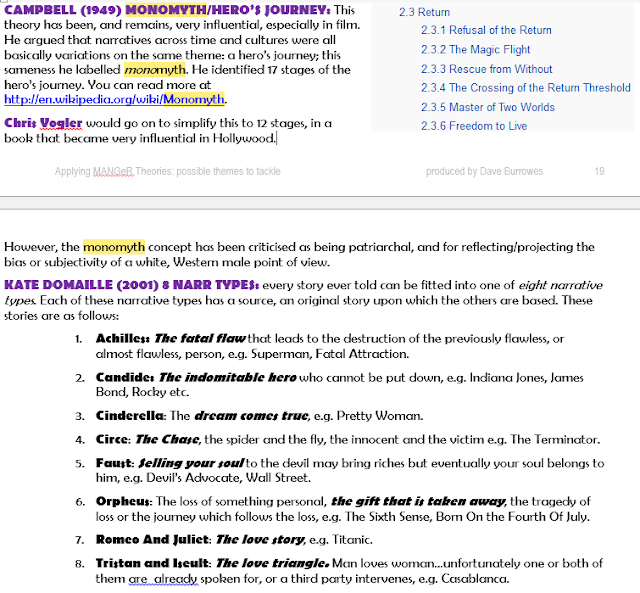This post is a work in progress. I've done multiple highly detailed posts on this, but I aim to simplify this major element of coursework in this post - with links for further material on some of the themes I'll highlight....
THE 5 BASIC THEMES OF YOUR COURSEWORK
Showing knowledge/understanding of filmic conventions, and making clear you've APPLIED research into these, is one of 5 fundamental strands of your coursework and its assessment:
- AUDIENCE
- INDUSTRY + TECHNOLOGY
- CONVENTIONS
- PRE-PRODUCTION/PLANNING
- REFLECTION - PRESENTED CREATIVELY USING TECHNOLOGY
You need to first research the general conventions of film openings ... generally!!
If you are channel surfing, and VERY quickly unconsciously assessing what format you're seeing (that's news; soap; sitcom etc), you are processing media language clues or signifiers. Your challenge in coursework is to identify the media language that immediately identifies a text as belonging to a certain format - in this case not just film, but film opening.You'll analyse a number of film openings from different genres, then summarise your findings with at least 1 vodcast backed up with additional posts on specific parts of the media language (eg idents, titles).
Once you've pitched and settled on a fixed idea, you'll repeat the process, this time focusing on GENRE, not GENERAL, examples. What media language enables an audience to quickly recognise a film opening as horror, rom-com etc? Again, you'll summarise your findings in at least 1 vodcast + further posts.
KEY FILM OPENING THEMES TO DISCUSS
There are infinite elements of the media language of film openings you could focus on, and you could spend days drilling into every single shot in a single film opening.
You are free to split the following themes into smaller topics, but this is my suggestion for helping you make links and comparisons between your opening analyses; organise your evidence of learning; and to set out clearly how this research has impacted your work/thinking. I will say more on each below.
- IDENTS, COMPANIES, PRODUCTION CONTEXT
- TITLES
- SOUND; GENRE SIGNIFICATION
- 1ST SHOT
- CENTRAL PROTAGONIST + NARRATIVE
- MISE-EN-SCENE FOR EXPOSITION
- TRANSITIONING TO MAIN FILM
- AUDIENCE/REPRESENTATIONS + OTHER POINTS
THEME 1: IDENTS, COMPANIES, PRODUCTION CONTEXT
How many idents do we expect, how long are they, are they simple/complex, is there a specific order, do they use music...This is a simple task, requiring limited use of terms/theory, but clear + specific research is key: look at a good range of openings, calculate the total running time of idents, and use this as a basis for estimating a typical number + duration.
NOTE: You will see some with none or only one; note those, but make clear they aren't typicalHow many idents do you expect to see? (3-4, but sometimes 1 or none!)
How long is a typical ident? (varies! typically 6/7 secs?)
Are idents typically complex or simple? (mostly simple?)
Do most have sound (jingle/music)? (yes, but look at audio bridge point)
Do we see any difference between studio/subsidiary + Indie movies on this? (studio idents often longer)
Is there any particular order (reflecting company role or size)?
Are they all for production co's, or also for distributor/s?
Is this the same order as in titles?
Is an audio bridge, starting the film audio, common over 1 or more ident? (you'll often see WT or Warp's ident with the film sound starting over it)
THEME 2: TITLES
Careful consideration of the number, duration, sequencing, design and selection of titles.
THE 3 CATEGORIES OF TITLES:
CAST
CHARACTERS
COMPANIES
(plus THE MAIN TITLE!)
Start/end time of main titles: 0:02-1:01
Running time of main titles: 1min
Titles in order using exact text (including case) [see this eg]
4 THEMES TO STRUCTURE TITLES RESEARCH + ANALYSIS
See below for some further pointers.
THE RAW NUMBERS:
- how many titles do you expect to see?
- provide counter-examples with very few or no opening titles
- what total running time is typical?
- again, note exceptions
THE SPECIFIC WORDING + ORDER:
Look carefully at the precise wording for each of these:
- companies (presents, a ... film/production, in association with...)
- director (auteur theory reflected in TWO credits - a ... film, directed by; where do these come in the order?)
- actors (introducing, starring, featuring, co-starring ...)
- technical roles (you need to be clear on which you will include; look for specifics eg director of photography or cinematography by?)
THE DESIGN
Look at use of these aspects and how they are used to distinguish/denote relative importance:
- (sans-)serif (consider to what degree titles connote genre here)
- size (names usually bigger than role, by etc; bigger stars bigger title?)
- colour
- case (UPPER, lower, Sentence case, maybe mixed)
FX, ANIMATION
Some titles are simply static, but often there's some form of movement...
- animation/movement/FX?
- transitions or straight cuts? fade to/-in from black?
- intertitles? (over black screen)
THE COMPANIES
State how many companies were credited, and use your earlier research to discuss why/what different terms were used for different companies. This is very important detail for creating convincing titles.
Look out for companies/institutions like Film4/BBC (often commission a film to be made), or BFI, National Lottery, UK Film Council, Screen Yorkshire, EM Media (etc) - who more often finance productions.
Try to use terms such as Indie, subsidiary, conglomerate, big six to denote the types of company.
ROLES
How many specific roles were given a title? How were actors roles split up? Are you surprised at how many/few there are? You could have a look at IMDB's full credits listing to get a sense of how selective these opening titles are!!!
Which ONE person gets TWO credits for the same role? Detail precisely the order/wording of this.
You must provide a complete list, in appropriate order + with appropriate wording, of titles you intend to use as a result of the research on roles + companies.
GENRE/NARRATIVE CONNOTATIONS
Denote (describe in detail, illustrating with screenshots) the design of the titles: font (Georgia is a serif font; Helvetica is a sans-serif font), colour, case (UPPER, lower, Sentence), size, positioning, any movement/animation, any additional graphical elements.
Discuss the probable preferred reading: what the filmmakers are trying to symbolically communicate to the audience. Do the titles/their design connote/signify the genre and/or anything about the narrative?
THEME 3: SOUND; GENRE SIGNIFICATION
How is sound used to provide narrative exposition and/or genre signification? This is also a key exam question!MUSIC (not necessarily non-diegetic; eg Baby Driver). Music genre usually helps to signify a likely genre (and audience), eg jazz: older (25-44+ or even older), upmarket (ABC1); heavy metal: youth (15-34+, older if an older band, youth if a cover version of an older band), downmarket (C2DE), possibly more male.
Consider editing of the sound: continuous (unlikely)? Any fading in/out (likely)? A mix of a main track and incidental music? pre-existing music or incidental music composed for the movie? Any obvious 'influences'/intertextuality? Its not uncommon to see some music video-style cutting to the beat...
AMBIENT SOUND/FOLEY SOUND: With the possible exception of social realist movies, much of the audio in film + TV is typically recorded separately from the main shoot, in post-production ('Foley sound'). The great Sergio Leone recorded ALL of his films' sound in post-production. Look at how sound creates verisimilitude.
Is there a voiceover (VO)?
Foley sound and successful ambient sound are key to achieving verisimilitude and continuity editing.
You will also consider use of audio bridges over idents and as part of the transition to main film; you could make a brief note of that here.
THEME 4: 1ST SHOT
How much/little is usually revealed through shot 1, and what media language is common (eg ELS/ES?)?
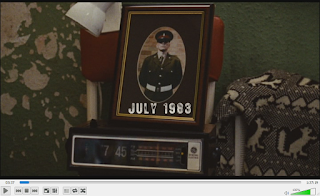 Look not just at what basic shot type is most common, but also the balance of narrative enigma and exposition from the 1st shot.
Look not just at what basic shot type is most common, but also the balance of narrative enigma and exposition from the 1st shot.This is England is a great example of a long take which has plenty of exposition through the mise-en-scene and radio audio, and even inter-titles to give the date, BUT lacks immediate dialogue to reveal accent (denoting likely location) and slowly builds to a reveal of the initially unseen central protagonist.
Psycho and Submarine are more typical, classic examples, using a series of cross-fading ELS to gradually settle on/reveal one location and a character(s) within. Psycho is the archetype of this approach, Hitchcock's editing here (starting with a cityscape and gradually cutting to a building then a window, and moving through it with a crane shot ... to reveal the scream queen archetype Marion Crane!) being widely referred to as the 'hand of god' technique. Its as if we the audience are seeing the fickle finger of fate picking out one un/fortunate character, with the subliminal message of it could be you adding impact to the film.
Low budget Warp X production For Those in Peril is a template of what not to do! We immediately see the face of our protagonist, the very opposite of using OTS, worm's eye shots of feet, variable focus and more to build narrative enigma around a/the central protagonist.
THEME 5: CENTRAL PROTAGONIST + NARRATIVE
How do filmmakers signify to audiences which character/s are the/a central protagonist/s? How much of the Todorov model do we see within the brief span of an opening (consider openings duration!)?This point requires a good amount of denotative detail, and is potentially excellent preparation for your exam (TV drama question).
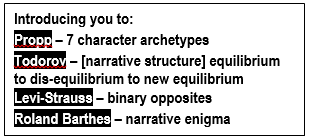 |
| Use the handout below to help with these |
WEIGHING ANCHOR
Consider, detail the techniques used to signify, probably anchor, a character (may be plural) as the central protagonist, eg:
- framing, rule of thirds;
- tighter framing than other characters (especially within shot reverse shot sequences), eg MS/MCU v MLS/LS; POV shots!!!
- angles;
- cutting back to them while others are speaking and/or OTS while others speak to keep them in frame;
- tracking/panning shots;
- voiceover;
- building, maintaining initial narrative enigma over their identity, possibly including avoiding revealing face;
- variable focus, shallow field of focus, focus push/pull (not necessarily focus on them initially - to keep their features obscured)
- distinctive colour, especially from birds eye (HA) ELS, crowd scenes
TODDLE OFF
For some of the above, its likely you can make reference to basic narrative theories of Propp (character archetypes expected in all drama), Levi Strauss (binary opposites).
Narrative enigma (Barthes) is key to the above (and your shot 1 analyses) - you could look at other 'codes' Barthes suggested too.
The 'narrative' part of this is especially focused on Todorov, however. Which stage/s if any of his basic 5 part narrative structure do we see? The initial equilibrium is very quickly disrupted in some; in others the disruption is very slow to emerge. Perhaps the order is different from Todorov's? Memento is a famous example, Goodfellas another - starting with a flashback (which works, to the audience, more like a flash forwards - a technique Breaking Bad made famous use of in TV drama). Nowell's book is great on this; I did a very short summary here.
In your possible influences on this one be very clear on which example/s will help guide you given your restrictive brief (the opening 2mins including titles). Perhaps you will leave your opening essentially incomplete, fading out as it continues?You need to state the length of a range of openings, then propose a typical running time for this, and which Todorov component/s it covers.
GUIDES + THE MONOMYTH
For convenience, I've added below a worksheet on (1) narrative theory and (2) the A2 exam theory pack. You should reference content from (1) and might dip into (2) for more. The screenshot is from the A2/Q1B exam theory pack; Campbell's theory actually helps make more sense of both Todorov and Propp...
THEME 6: MISE-EN-SCENE FOR EXPOSITION
This is where you need to go deeper into your semiotics: how do skilful directors employ mise-en-scene (costume, make-up, body language, setting/set-dressing, props...) to inform the audience rather than rely on dialogue/voiceover and/or titles?
Again, This is England is an excellent example of this. You will have focused on its first shot, so now consider the bike in the garden; the subway with its Screwdriver* graffiti, the prefab hut (actually a church!) with Maggie is a Twat grafitti; Shaun's trousers (which, along with that picture of his dad, are props that are used to drive the narrative of that opening sequence). *80s neo-Nazi 'Oi' band, actually spelt Skrewdriver, so maybe a point there too about the intelligence of the hypothetical grafitti writers...
Sometimes it won't seem so obvious - Four Lions is a good example; you have to think about the wealth of information and hints provided non-verbally. You could consider the extent to which dialogue is/n't used.
Feel free to voice strong clear personal opinions in your writing - if you think a director is showing genius or laziness, say so!!!I've highlighted this as an area because if your work is to be sophisticated it must shine in this regard.
For any example precise denotation is key - and this is a skill often lacking in AS exam work. The what/how and why are equally important.
THEME 7: TRANSITIONING TO MAIN FILM
This is a short aspect you're examining: how specifically we move from the opening to the main body of the film. Video clips/gifs will be especially useful for this. Horror/slasher films often either cut sharply to a main title and fade in from black (to a relative of the person just killed) or, a more common approach across all genres, fade to black and back in again, with main title and titles sequence over this post-opening phase, not the opening itself.
Even if you don't get to include this in your own production, it is part of what you need to show you have (a) researched; (b) have knowledge and understanding of - (c) applying this will depend on your idea. It may be preferable to fade out from your opening while the action continues - exam board reports often criticize closed narratives as short film-like.
Again, clear, specific denotation is crucial, especially on editing techniques, but also looking at common narrative/plot devices.
THEME 8: AUDIENCE/REPRESENTATIONS + OTHER POINTS
This is partly your catch-all topic: everything else we noticed but which didn't fit clearly into other themes!
You could use this partially to focus on the 'bad' examples you noted; how not to do it.
AUDIENCE/REPRESENTATIONS
This sets you up for quality audience research. The exam board frequently point to audience research + analysis as being a relative weakness in both coursework and exams (globally, not StG). If you can provide a sharply defined target audience, then back this up with research, while also keep referencing this as your idea/production/edit evolves, you'll avoid that trap!
There is overlap here with work on narrative/protagonists.
What commercial (impact on box office) impact does a high rating have?
What commercial (impact on box office) impact does a low rating have?
What do the controversies over This is England and (also social realist but not Warp) Sweet Sixteen, compared to the treatment of The Dark Knight (not WT) and World's End (WT) suggest about the BBFC's treatment of Indie and studio productions respectively?
You should create a 4-column table with WT/Warp films + age rating + UK box office + global box office, ordered from low age rating to high (U, PG, 12, 15, 18).
CAST + CHARACTERS; REPRESENTATIONS
Consider how the range of protagonists, main supporting characters, and antagonists and how the character is portrayed, plus the actual cast (look at posters as part of this) helps to denote the likely primary and secondary audiences. Can you find a clear four quadrant example? Is there a link to budget (and therefore ownership?)? Are stereotypes or countertypes more likely to boost commercial (box office) potential, especially for British productions seeking international distribution? Use my points below to help with this.
ISSUES: SOCIAL CLASS; NATIONALITY, ETHNICITY, REGIONAL ACCENT
Consider the social class of typical Warp/WT protagonists. Contrast the complex working-class protagonist of Tyrannosaur with the crude stereotype of Grimsby. Go a step further - why did Grimsby still fail internationally? Did The World's End have any similar problems?
Why did WT2's Mickybo and Me flop while the very similar narrative of Son of Rambow succeeded on a lower budget? Can you identify 5 WT rom-coms that use white, Southern English, middle-class protagonists and London/rural southern England settings (note their box office)? Use screenshots from Bridget Jones' Diary. Compare with Warp/Warp X's Submarine, She a Chinese, '71, This is England, Four Lions, noting their setting, protagonist's accent/regional identity and box office.
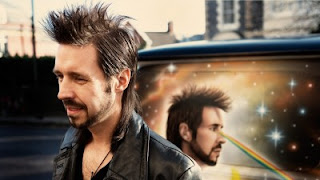 |
| How does this actor/character help to widen Submarine's appeal to an older, secondary audience? What theory does that make you think of?! |
ISSUES: AGE/GENDER + INTERTEXTUALITY
Which characters/cast did Warp use to strengthen the secondary adult, 35-44+ appeal of their teen/youth rom-com Submarine?
Which characters/cast did WT use to strengthen the secondary adult, 35-44+ appeal of their teen/youth rom-com About Time? How does this also demonstrate potential (Stuart Hall's preferred reading concept...) intertextuality? (hint: the cinematic atrocity that is Love Actually)
How can the OST of The World's End help explain its relative failure to attract a four quadrant audience in contrast to the preceding Cornetto Trilogy movies?
Can you apply the uses and gratifications theory to show how 1 film may have succeeded and another flopped?
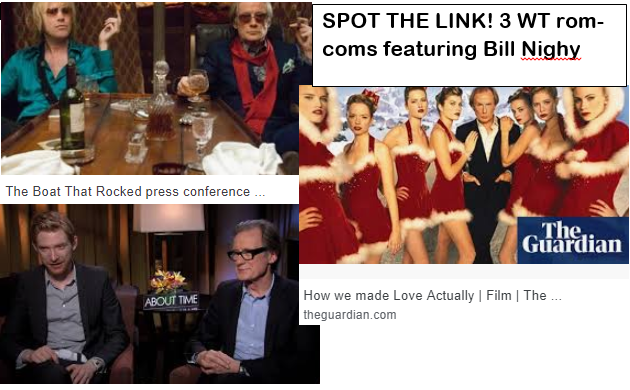 |
| BTW, I simply combined these 3 images in Word + took a screenshot rather than have 3 scrolling images! |

